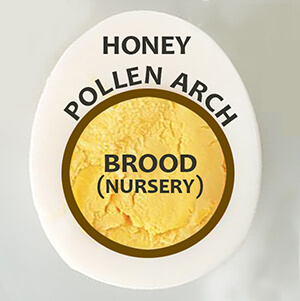
It’s really tough being a new beekeeper. You’re trying to make sense of a jumble of insects that live together in a colony of 30-50,000 individuals, with each of those worker bees equipped to dole out stings if you mess up. It’s a little terrifying. Congratulate yourself for considering it—you’re a brave, courageous soul. Usually the bees are extremely gentle and easy to work, especially once you get comfortable manipulating a colony.
Most new beekeepers don’t jump in completely blind. Perhaps you’ve read a book or two on beekeeping basics, maybe even attended a beekeeping short course. All those images and ideas are floating in your head as you approach your colony, ready to work it.
Dressed in a suit or veil, you smoke the colony entrance, and wait a moment to let the bees know you’re coming. Being new, you want the bees to stay calm. So you lift up the cover that telescopes over the top box and puff a little more smoke, gently letting the lid back down to keep the smoke in the colony.
After 30 seconds of letting the smoke and bees settle, you lift off the lid, remove the inner cover, revealing the open hive. But what in the heck are you actually seeing other than a teeming mass of bees?
Apis mellifera, the European honey bees we attempt to manage as beekeepers, are cavity dwellers. They typically set up their home in a hollow tree, drawing wild comb that’s fixed to the top and sides of that protected space. They organize the space in a specific way (Fig. 1), with the nursery or broodnest in the warm center and the well-stocked larder of pollen and honey within reach right above.
Modern day beekeepers keep their colonies in hives with moveable frames, which makes it harder to visualize the natural structure of the hive. Picture a hardboiled egg, sliced straight through and you get a pretty good sense of a colony’s normal structure (Fig. 2). The deep yellow yolk is where the bees tend their nursery, raising more bees. That thin skin on the yolk, which is often a little greenish grey represents the arch of pollen, always stored right on the edge of the broodnest. Above the pollen arch the bees pack in nectar that they turn into honey.
Now cram that hardboiled egg into a two-story 10-frame hive (Fig. 3). Notice that the frames in the center of the top box will have the traditional arch shape with brood in the center bottom, topped with a swath of pollen and honey stored along the edges (Fig. 4).
When working a colony, you want to try and maintain this ….


